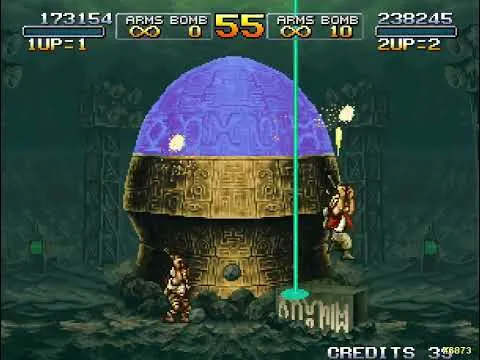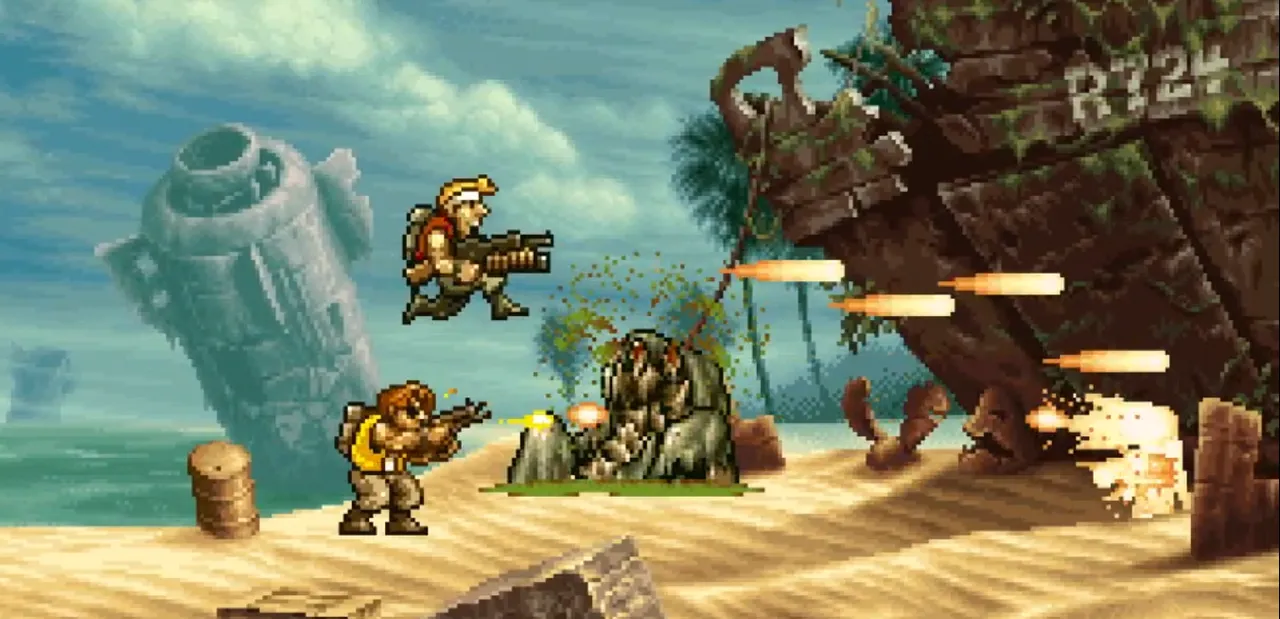

Some weeks ago, a buddy showed up again at my home and then we spent a while thinking about something new to try out, since I wanted to give a shot to something that wasn't Zelda Four Swords Adventures (if only because most of the time we played that due to the campaign progression).
And then I remembered Metal Slug 3.
Apparently he hadn't played it before, but I had played some Contra games with him, so it was not all that bad to beat...
...right?
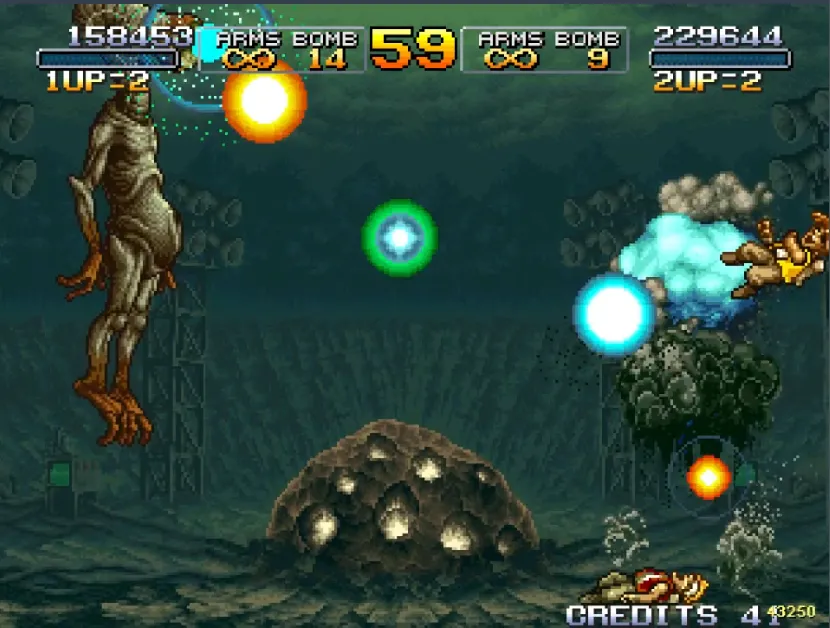
Metal Slug is one of those games considered old-time classics of all time, as well as one that has really stood the test of time thanks to its insanely detailed and animated sprites, SPECIALLY with how this was released in 2000, both passing off as something you could see from not too long ago as well as a surprisingly detailed 2D game right at the corner of the the new millenium and how everybody had their attention on 3D games instead.
...but it is also known by being one of THOSE games that will squeeze you effortlessly through its difficulty. You could call it the "son of Contra" (I wanted to say "brother"...but the first Contra games did come out quite a wile before Metal Slug), but while Contra DOES often try to hit a middle point of difficulty and fairness in most console releases (Hard Corps and 4 notwithstanding), those games send you back to the beginning or checkpoint of the stage if you die and decide to continue.
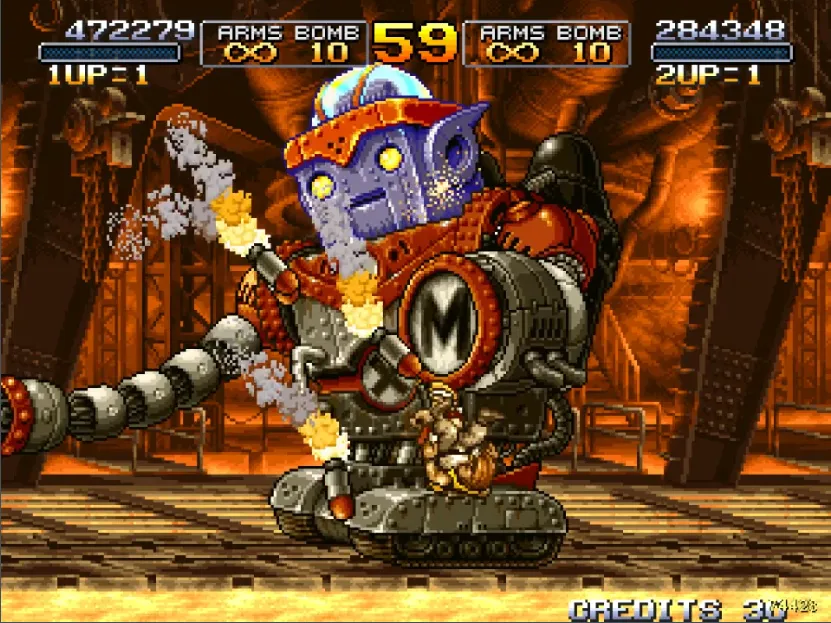
On the other hand, Metal Slug will just barrel you from every single side possible (these are called "coin-eaters", as arcade operators would quite benefit from games like these)...but if you continue, you WON'T return to the beginning of the stage. This is the bit of lenience that Metal Slug has that separates it from Contra: With only two arcade Contra games release that also allow you to do this, the rest of the franchise asks you for practice and effort to actually progress in the levels.
With this game, it depends of the version you're playing.
Some versions might only offer you a set number of credits per player, like 20 for the Steam version, or just 5 credits by default on the Neo Geo MVS version (ouch). The classic Xbox version not only seems to have limited credits too...but also the continue system is just like home Contra: Lose your lives in a stage? Back to the beginning of the stage!
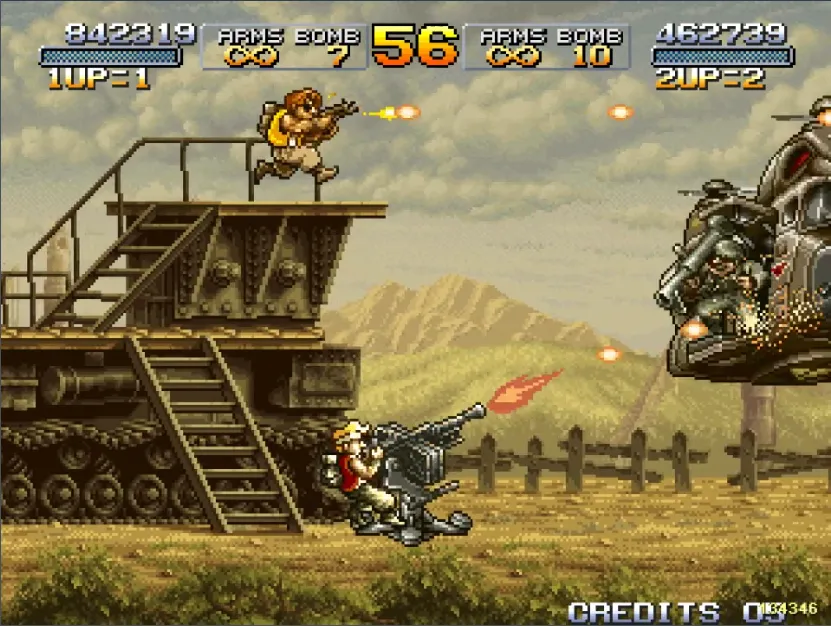
But a few versions have Free Play available, and emulating the arcade version can both offer that and simply inserting coins wherever you want. This makes for a quite different experience: Dying is basically an annoyance that gets rid of your weapon, more than a mounting pressure for you to get better or be kicked out when it's too late. In a nutshell, we could die a lot even when trying not to...but there weren't reasons to get THAT good at the game with practice to go through it.
Was it still an entertaining ride? Yes! And it still is an amazing looking game with great soundtrack and a lot of explosions...but just like some other arcade games out there, there's definitely something that can be missing from being virtually immortal due to infinite credits. In retrospective, the feeling can be like watching a cheap movie: You enjoy the fireworks, but there really aren't any stakes; just spending a while on the ride with a buddy.
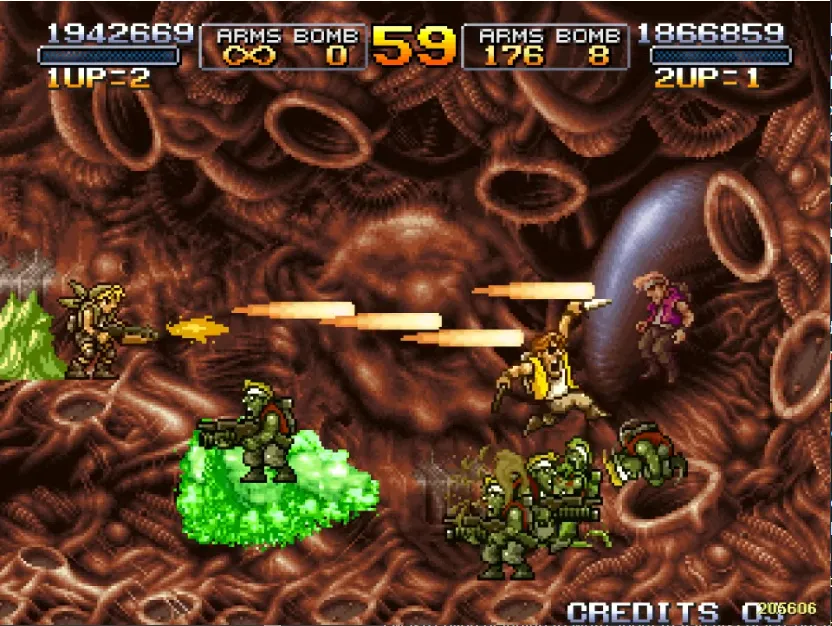
These games definitely can have an incentive of challenge-derived fun (just look at Dark Souls players) from trying to set a challenge with limited credits on your own, or even have a buddy that also practiced that on their own and try to take on the game as far as they can with combined practice. But at the very minimum, infinite credits can technically make this one a game that anyone can complete with enough time and patience for repeated deaths.
The kind of value you can get from this game on that regard can definitely be a subjective matter though, and it was fine for a casual evening with a buddy because actually grinding just to progress in an arcade game can be quite time consuming; deaths still being a nuisance with wasting time rather than an inmediate obstacle forcing you to retry over and over. But even then it might take just a little over an hour, so it can be a relatively short ride to sit through.
I wasn't even planning to write about that in first place, but it came immediately to mind while writing about the difficulty of the game, since it happens to combo in a "schrodinger difficulty" of very hard to complete efficiently, and yet very easy to complete at all (at least with versions using Free Play/Infinite Credits or without any self-imposed continue limit)...but hey, I recorded that whole playthrough so you can check out how that disaster went if you want!
today's bonus image
If you've seen this fish before, congratulations!
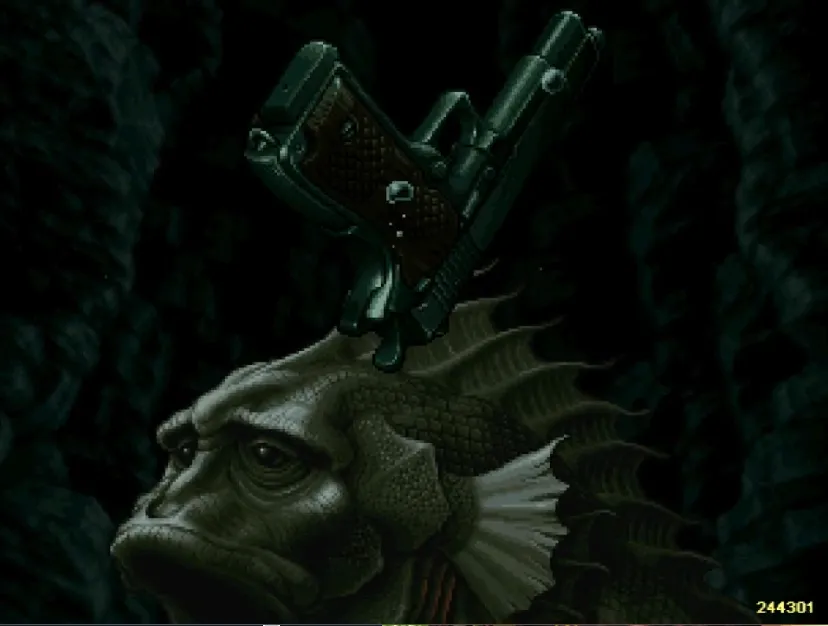

Spanish translation with DeepL. All screenshots were captured by myself.
Español
Hace unas semanas, un amigo se presentó de nuevo en mi casa y estuvimos un rato pensando en algo nuevo que probar, ya que quería darle una oportunidad a algo que no fuera Zelda Four Swords Adventures (aunque sólo sea porque la mayoría de las veces jugamos a eso debido a la progresión de la campaña).
Y entonces me acordé de Metal Slug 3.
Aparentemente no lo había jugado antes, pero yo había jugado con él a algunos juegos de Contra, así que no era tan malo de superar...
...¿verdad?

Metal Slug es uno de esos juegos considerados clásicos de todos los tiempos, así como uno que realmente ha resistido la prueba del tiempo gracias a sus sprites insanamente detallados y animados, ESPECIALMENTE con la forma en que este fue lanzado en 2000, tanto pasando como algo que podrías ver de no hace mucho tiempo como un juego 2D sorprendentemente detallado justo en la esquina del nuevo milenio y cómo todo el mundo tenía su atención en los juegos 3D en su lugar.
...pero también es conocido por ser uno de ESOS juegos que te exprimen sin esfuerzo por su dificultad. Se le podría llamar el "hijo de Contra" (quería decir "hermano"... pero los primeros juegos de Contra salieron bastante antes que Metal Slug), pero mientras Contra SÍ intenta llegar a un punto medio de dificultad y equidad en la mayoría de las versiones de consola (a pesar de Hard Corps y 4), esos juegos te devuelven al principio o al punto de control de la fase si mueres y decides continuar.

Por otro lado, Metal Slug se limitará a lanzarte desde todos los lados posibles (estos se llaman "come-monedas", ya que los operadores de arcade se beneficiarían bastante de juegos como estos)... pero si continúas, no volverás al principio de la fase. Este es el aspecto que diferencia a Metal Slug de Contra: Con sólo dos juegos arcade de Contra que también te permiten hacer esto, el resto de la franquicia te pide práctica y esfuerzo para realmente progresar en los niveles.
Con este juego, depende de la versión a la que juegues.
Algunas versiones sólo te ofrecen un número determinado de créditos por jugador, como 20 en la versión de Steam, o sólo 5 créditos por defecto en la versión de Neo Geo MVS (ouch). La versión clásica de Xbox no solo parece tener créditos limitados... sino que además el sistema de continuación es igual que el de Contra de casa: ¿Pierdes tus vidas en una fase? **Vuelve al principio de la fase.

Sin embargo, algunas versiones disponen de Free Play, y la emulación de la versión arcade puede ofrecer tanto eso como simplemente insertar monedas donde quieras. Esto hace que la experiencia sea bastante diferente: Morir es básicamente una molestia que te quita el arma, más que una presión creciente para que mejores o te echen cuando sea demasiado tarde. En pocas palabras, podíamos morir mucho aunque intentáramos no hacerlo... pero no había motivos para volverse TAN bueno en el juego con la práctica para superarlo.
¿Seguía siendo un juego entretenido? Sí. Y sigue siendo un juego con un aspecto increíble, con una gran banda sonora y un montón de explosiones... pero al igual que otros juegos arcade que existen, definitivamente hay algo que puede faltar al ser prácticamente inmortal debido a los créditos infinitos. En retrospectiva, la sensación puede ser como ver una película barata: Disfrutas de los fuegos artificiales, pero en realidad no hay nada en juego; sólo pasas un rato en la atracción con un amigo.

Definitivamente, estos juegos pueden tener un incentivo de diversión derivado de los retos (basta con mirar a los jugadores de Dark Souls) al intentar establecer un reto con créditos limitados por tu cuenta, o incluso tener un compañero que también lo haya practicado por su cuenta e intentar llevar el juego lo más lejos posible con la práctica combinada. Pero como mínimo, los créditos infinitos pueden hacer de éste un juego que cualquiera puede completar con el tiempo y la paciencia suficientes para repetir las muertes.
El tipo de valor que puedes obtener de este juego en ese sentido puede ser definitivamente una cuestión subjetiva, y estaba bien para una tarde casual con un amigo, porque en realidad moler sólo para progresar en un juego de arcade puede consumir bastante tiempo; las muertes siguen siendo una molestia con la pérdida de tiempo en lugar de un obstáculo inmediato que te obliga a reintentar una y otra vez. Pero incluso en ese caso puede durar poco más de una hora, por lo que puede ser un paseo relativamente corto para sentarse.
Ni siquiera planeaba escribir sobre eso en primer lugar, pero me vino a la mente inmediatamente mientras escribía sobre la dificultad del juego, ya que resulta que es un combo en una "dificultad schrodinger" de muy difícil de completar eficientemente, y a la vez muy fácil de completar en absoluto (al menos con las versiones que usan Juego Gratis/Créditos Infinitos o sin ningún límite de continuación autoimpuesto)... pero bueno, ¡grabé todo ese playthrough así que puedes ver cómo fue ese desastre si quieres!
today's bonus image
Si alguna vez has visto este pez antes, felicidades!


Traducción al español hecha con DeepL. Todas las fotos capturadas por mí.
